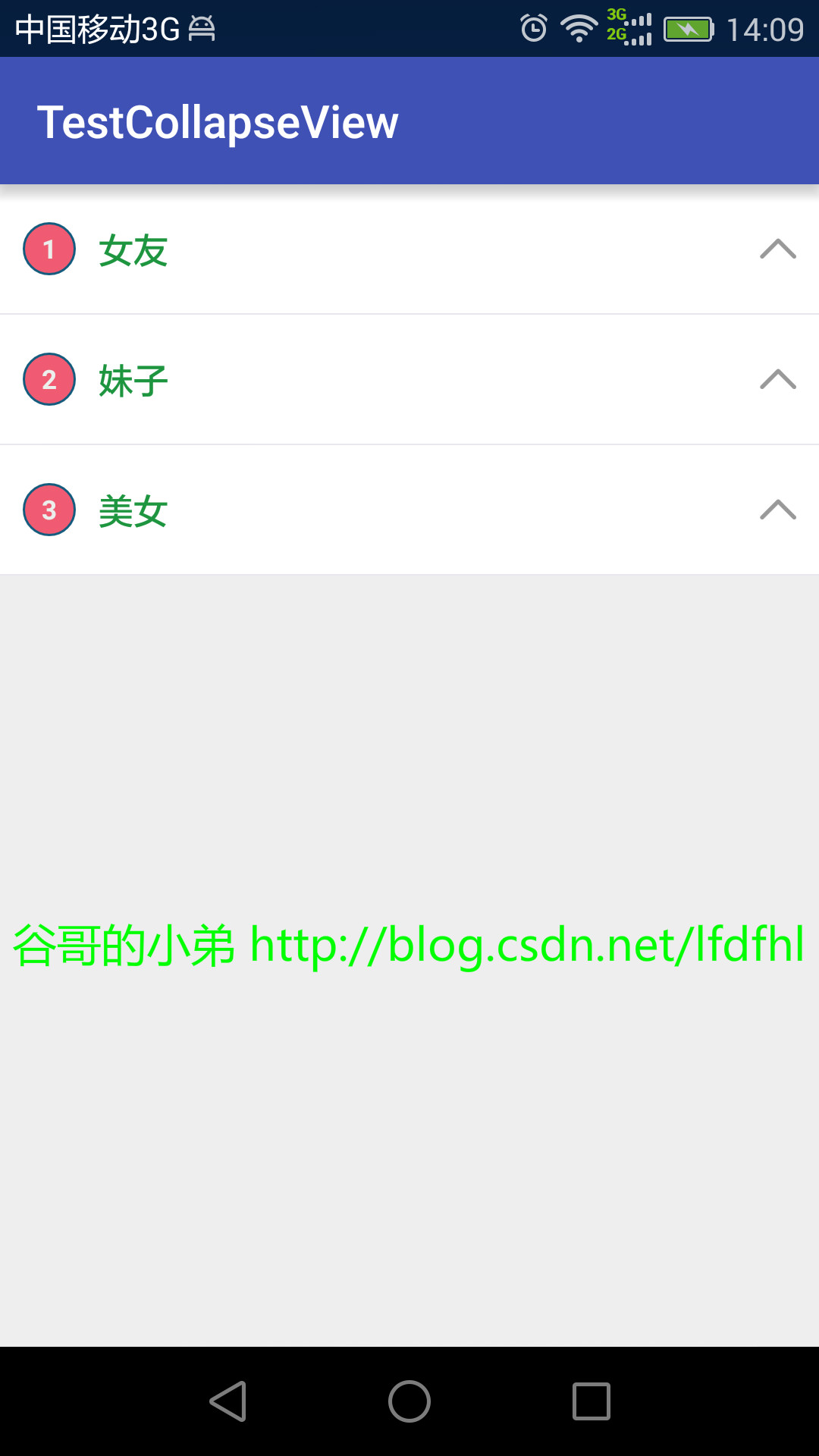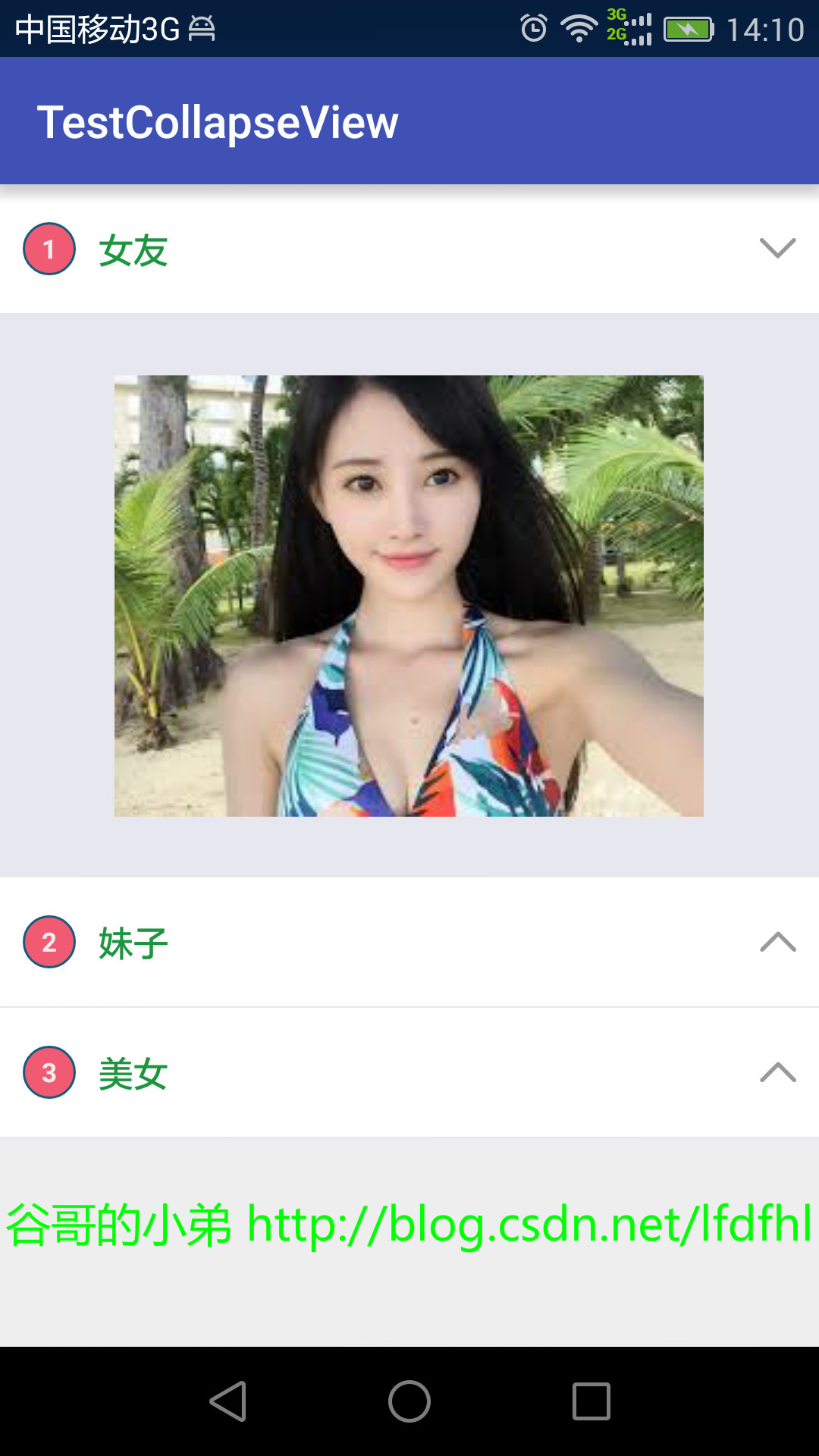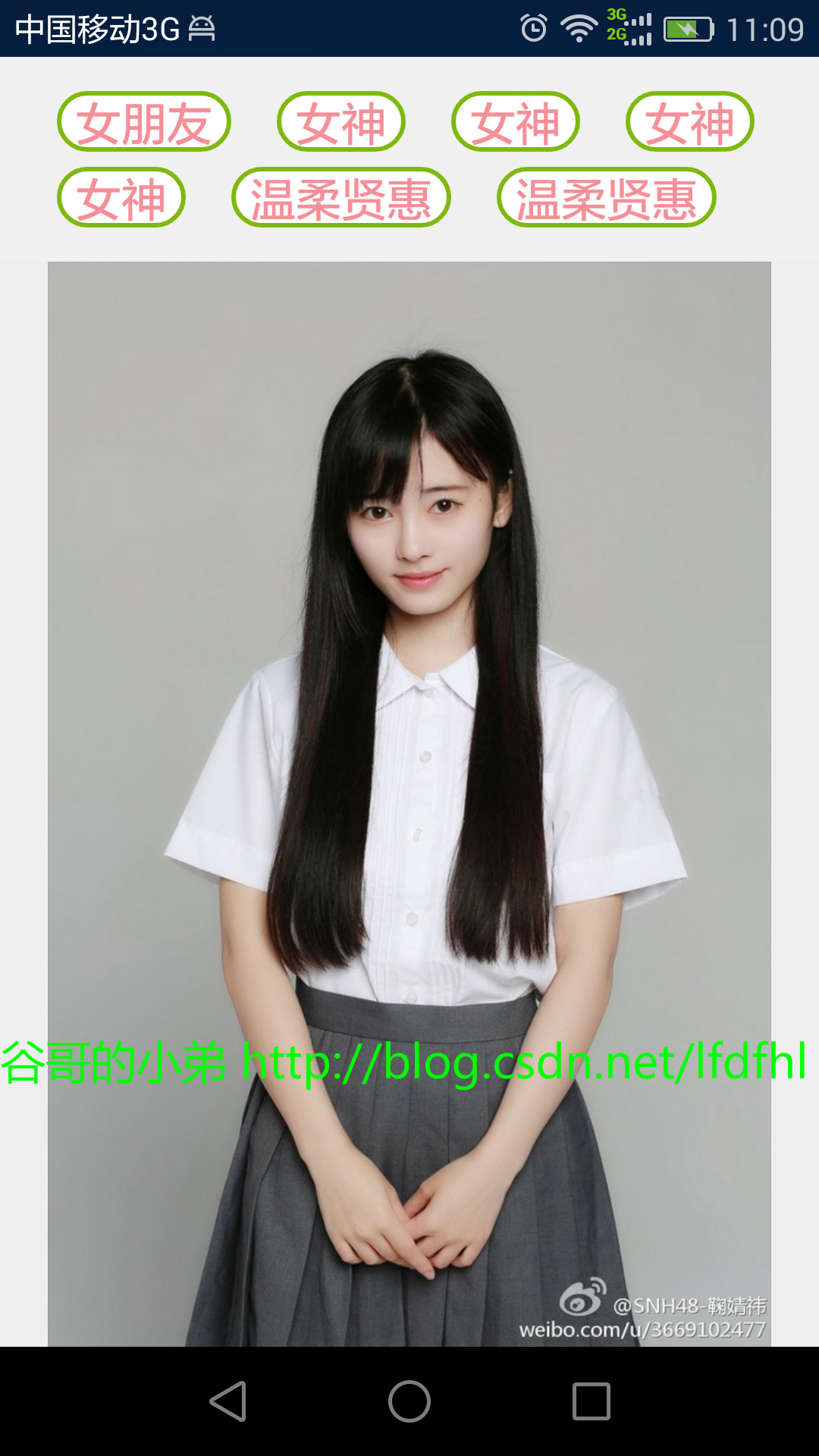編輯:關於Android編程
之前結合源碼分析完了自定義View的三個階段:measure,layout,draw。
那麼,自定義有哪幾種常見的方式呢?
直接繼承自View
在使用該方式實現自定義View時通常的核心操作都在onDraw( )當中進行。但是,請注意,在分析measure部分源碼的時候,我們提到如果直接繼承自View在onMeasure( )中要處理view大小為wrap_content的情況,否則這種情況下的大小和match_parent一樣。除此以為,還需要注意對於padding的處理。
繼承自系統已有的View
比如常見的TextView,Button等等。如果采用該方式,我們只需要在系統控件的基礎上做出一些調整和擴展即可,而且也不需要去自己支持wrap_content和padding。
直接繼承自ViewGroup
如果使用該方式實現自定義View,請注意兩個問題
第一點:
在onMeasure( )實現wrap_content的支持。這點和直接繼承自View是一樣的。
第二點:
在onMeasure( )和onLayout中需要處理自身的padding以及子View的margin
繼承自系統已有的ViewGroup
比如LinearLayout,RelativeLayout等等。如果采用該方式,那麼在3中提到的兩個問題就不用再過多考慮了,簡便了許多。
在此,舉兩個例子。
瞅瞅第一個例子,效果如下圖:


對於該效果的主要描述如下:
好了,效果已經看到了,我們來明確和拆解一下這個小功能
控件由數字,標題,箭頭,圖片四部分組成 點擊標題逐漸地顯示或隱藏圖片 在圖片的切換過程中伴隨著箭頭方向的改變弄清楚這些就該動手寫代碼了。
先來看這個控件的布局文件
請注意,在此將顯示圖片的容器即contentRelativeLayout設置為gone。
為什麼要這麼做呢?因為進入應用後是看不到圖片部分的,只有點擊後才可見。嗯哼,你大概已經猜到了:圖片的隱藏和顯示是通過改變容器的visibility實現的。是的!那圖片的逐漸顯示和隱藏還有箭頭的旋轉又是怎麼做的呢?請看該控件的具體實現。
package com.stay4it.testcollapseview;
import android.content.Context;
import android.text.TextUtils;
import android.util.AttributeSet;
import android.util.DisplayMetrics;
import android.view.LayoutInflater;
import android.view.View;
import android.view.WindowManager;
import android.view.animation.Animation;
import android.view.animation.Transformation;
import android.widget.ImageView;
import android.widget.LinearLayout;
import android.widget.RelativeLayout;
import android.widget.TextView;
/**
* 原創作者:
* 谷哥的小弟
*
* 博客地址:
* http://blog.csdn.net/lfdfhl
*/
public class CollapseView extends LinearLayout {
private long duration = 350;
private Context mContext;
private TextView mNumberTextView;
private TextView mTitleTextView;
private RelativeLayout mContentRelativeLayout;
private RelativeLayout mTitleRelativeLayout;
private ImageView mArrowImageView;
int parentWidthMeasureSpec;
int parentHeightMeasureSpec;
public CollapseView(Context context) {
this(context, null);
}
public CollapseView(Context context, AttributeSet attrs) {
super(context, attrs);
mContext=context;
LayoutInflater.from(mContext).inflate(R.layout.collapse_layout, this);
initView();
}
private void initView() {
mNumberTextView=(TextView)findViewById(R.id.numberTextView);
mTitleTextView =(TextView)findViewById(R.id.titleTextView);
mTitleRelativeLayout= (RelativeLayout) findViewById(R.id.titleRelativeLayout);
mContentRelativeLayout=(RelativeLayout)findViewById(R.id.contentRelativeLayout);
mArrowImageView =(ImageView)findViewById(R.id.arrowImageView);
mTitleRelativeLayout.setOnClickListener(new OnClickListener() {
@Override
public void onClick(View v) {
rotateArrow();
}
});
collapse(mContentRelativeLayout);
}
public void setNumber(String number){
if(!TextUtils.isEmpty(number)){
mNumberTextView.setText(number);
}
}
public void setTitle(String title){
if(!TextUtils.isEmpty(title)){
mTitleTextView.setText(title);
}
}
public void setContent(int resID){
View view=LayoutInflater.from(mContext).inflate(resID,null);
RelativeLayout.LayoutParams layoutParams=
new RelativeLayout.LayoutParams(LayoutParams.MATCH_PARENT, LinearLayout.LayoutParams.WRAP_CONTENT);
view.setLayoutParams(layoutParams);
mContentRelativeLayout.addView(view);
}
public void rotateArrow() {
int degree = 0;
if (mArrowImageView.getTag() == null || mArrowImageView.getTag().equals(true)) {
mArrowImageView.setTag(false);
degree = -180;
expand(mContentRelativeLayout);
} else {
degree = 0;
mArrowImageView.setTag(true);
collapse(mContentRelativeLayout);
}
mArrowImageView.animate().setDuration(duration).rotation(degree);
}
@Override
protected void onMeasure(int widthMeasureSpec, int heightMeasureSpec) {
super.onMeasure(widthMeasureSpec, heightMeasureSpec);
parentWidthMeasureSpec=widthMeasureSpec;
parentHeightMeasureSpec=heightMeasureSpec;
}
@Override
protected void onLayout(boolean changed, int l, int t, int r, int b) {
super.onLayout(changed, l, t, r, b);
}
// 展開
private void expand(final View view) {
WindowManager wm = (WindowManager) mContext.getSystemService(Context.WINDOW_SERVICE);
DisplayMetrics outMetrics = new DisplayMetrics();
wm.getDefaultDisplay().getMetrics(outMetrics);
view.measure(parentWidthMeasureSpec, parentHeightMeasureSpec);
final int measuredWidth = view.getMeasuredWidth();
final int measuredHeight = view.getMeasuredHeight();
view.setVisibility(View.VISIBLE);
Animation animation = new Animation() {
@Override
protected void applyTransformation(float interpolatedTime, Transformation t) {
if(interpolatedTime == 1){
view.getLayoutParams().height =measuredHeight;
}else{
view.getLayoutParams().height =(int) (measuredHeight * interpolatedTime);
}
view.requestLayout();
}
@Override
public boolean willChangeBounds() {
return true;
}
};
animation.setDuration(duration);
view.startAnimation(animation);
}
// 折疊
private void collapse(final View view) {
final int measuredHeight = view.getMeasuredHeight();
Animation animation = new Animation() {
@Override
protected void applyTransformation(float interpolatedTime, Transformation t) {
if (interpolatedTime == 1) {
view.setVisibility(View.GONE);
} else {
view.getLayoutParams().height = measuredHeight - (int) (measuredHeight * interpolatedTime);
view.requestLayout();
}
}
@Override
public boolean willChangeBounds() {
return true;
}
};
animation.setDuration(duration);
view.startAnimation(animation);
}
}
現就該代碼中的主要操作做一些分析和介紹。
控件提供setNumber()方法用於設置最左側的數字,請參見代碼第62-66行。實現content部分的顯示,請參見代碼第110-138行
在這遇到一個難題:
這個content會占多大的空間呢?
我猛地這麼一問,大家可能有點懵圈。
如果沒有聽懂或者回答不上來,我就先舉個例子:
小狗一秒鐘跑1米(即小狗的速度為1m/s),請問小狗跑完這段路要多少時間?
看到這個問題,是不是覺得挺腦殘的,是不是有一種想抽我耳光的沖動?
你他妹的,路程的長短都沒有告訴我,我怎麼知道小狗要跑多久?!真是日了狗了!
嗯哼,是的。我們在這裡根本不知道這個View(比如此處的content)有多高多寬,我們當然也不知道它要占多大的空間!!那怎麼辦呢?在這就按照最直接粗暴的方式來——遇到問題,解決問題!找出該View的寬和高!
前面在分析View的measure階段時我們知道這些控件的寬和高是由系統測量的,在此之後我們只需要利用getMeasuredWidth()和getMeasuredHeight()就行了。但是這個控件的visibility原本是GONE的,系統在measure階段根本不會去測量它的寬和高,所以現在需要我們自己去手動測量。代碼如下:
view.measure(parentWidthMeasureSpec, parentHeightMeasureSpec);
獲取到view的寬高後借助於動畫實現content的漸次展開,請參見代碼第119-137行。
動畫的interpolatedTime在一定時間內(duration)從0變化到1,所以
measuredHeight * interpolatedTime
表示了content的高從0到measuredHeight的逐次變化,在這個變化的過程中不斷調用
view.requestLayout();
刷新界面,這樣就達到了預想的效果。
實現content部分的隱藏,請參見代碼第141-161行
隱藏的過程和之前的逐次顯示過程原理是一樣的,不再贅述。
實現箭頭的轉向,請參見代碼第83-95行
這個比較簡單,在此直接用屬性動畫(ViewPropertyAnimator)讓箭頭旋轉
示例小結:
在該demo中主要采用了手動測量View的方式獲取View的大小。
瞅瞅第二個例子,效果如下圖:

嗯哼,這個流式布局(FlowLayout)大家可能見過,它常用來做一些標簽的顯示。比如,我要給我女朋友的照片加上描述,我就可以設置tag為:”賢良淑德”, “女神”, “年輕美貌”, “清純”, “溫柔賢惠”等等。而且在標簽的顯示過程中,如果這一行沒有足夠的空間顯示下一個標簽,那麼會先自動換行然後再添加新的標簽。
好了,效果已經看到了,我們來瞅瞅它是怎麼做的。
package com.stay4it.testflowlayout;
import android.content.Context;
import android.util.AttributeSet;
import android.view.View;
import android.view.ViewGroup;
/**
* 原創作者:
* 谷哥的小弟
*
* 博客地址:
* http://blog.csdn.net/lfdfhl
*/
public class MyFlowLayout extends ViewGroup{
private int verticalSpacing = 20;
public MyFlowLayout(Context context, AttributeSet attrs) {
super(context, attrs);
}
@Override
protected void onMeasure(int widthMeasureSpec, int heightMeasureSpec) {
int widthSpecMode = MeasureSpec.getMode(widthMeasureSpec);
int widthSpecSize = MeasureSpec.getSize(widthMeasureSpec);
int heightSpecMode = MeasureSpec.getMode(heightMeasureSpec);
int heightSpecSize = MeasureSpec.getSize(heightMeasureSpec);
int paddingLeft = getPaddingLeft();
int paddingRight = getPaddingRight();
int paddingTop = getPaddingTop();
int paddingBottom = getPaddingBottom();
int widthUsed = paddingLeft + paddingRight;
int heightUsed = paddingTop + paddingBottom;
int childMaxHeightOfThisLine = 0;
int childCount = getChildCount();
for (int i = 0; i < childCount; i++) {
View child = getChildAt(i);
if (child.getVisibility() != GONE) {
int childUsedWidth = 0;
int childUsedHeight = 0;
measureChild(child,widthMeasureSpec,heightMeasureSpec);
childUsedWidth += child.getMeasuredWidth();
childUsedHeight += child.getMeasuredHeight();
LayoutParams childLayoutParams = child.getLayoutParams();
MarginLayoutParams marginLayoutParams = (MarginLayoutParams) childLayoutParams;
childUsedWidth += marginLayoutParams.leftMargin + marginLayoutParams.rightMargin;
childUsedHeight += marginLayoutParams.topMargin + marginLayoutParams.bottomMargin;
if (widthUsed + childUsedWidth < widthSpecSize) {
widthUsed += childUsedWidth;
if (childUsedHeight > childMaxHeightOfThisLine) {
childMaxHeightOfThisLine = childUsedHeight;
}
} else {
heightUsed += childMaxHeightOfThisLine + verticalSpacing;
widthUsed = paddingLeft + paddingRight + childUsedWidth;
childMaxHeightOfThisLine = childUsedHeight;
}
}
}
heightUsed += childMaxHeightOfThisLine;
setMeasuredDimension(widthSpecSize, heightUsed);
}
@Override
protected void onLayout(boolean changed, int l, int t, int r, int b) {
int paddingLeft = getPaddingLeft();
int paddingRight = getPaddingRight();
int paddingTop = getPaddingTop();
int paddingBottom = getPaddingBottom();
int childStartLayoutX = paddingLeft;
int childStartLayoutY = paddingTop;
int widthUsed = paddingLeft + paddingRight;
int childMaxHeight = 0;
int childCount = getChildCount();
for (int i = 0; i < childCount; i++) {
View child = getChildAt(i);
if (child.getVisibility() != GONE) {
int childNeededWidth, childNeedHeight;
int left, top, right, bottom;
int childMeasuredWidth = child.getMeasuredWidth();
int childMeasuredHeight = child.getMeasuredHeight();
LayoutParams childLayoutParams = child.getLayoutParams();
MarginLayoutParams marginLayoutParams = (MarginLayoutParams) childLayoutParams;
int childLeftMargin = marginLayoutParams.leftMargin;
int childTopMargin = marginLayoutParams.topMargin;
int childRightMargin = marginLayoutParams.rightMargin;
int childBottomMargin = marginLayoutParams.bottomMargin;
childNeededWidth = childLeftMargin + childRightMargin + childMeasuredWidth;
childNeedHeight = childTopMargin + childBottomMargin + childMeasuredHeight;
if (widthUsed + childNeededWidth <= r - l) {
if (childNeedHeight > childMaxHeight) {
childMaxHeight = childNeedHeight;
}
left = childStartLayoutX + childLeftMargin;
top = childStartLayoutY + childTopMargin;
right = left + childMeasuredWidth;
bottom = top + childMeasuredHeight;
widthUsed += childNeededWidth;
childStartLayoutX += childNeededWidth;
} else {
childStartLayoutY += childMaxHeight + verticalSpacing;
childStartLayoutX = paddingLeft;
widthUsed = paddingLeft + paddingRight;
left = childStartLayoutX + childLeftMargin;
top = childStartLayoutY + childTopMargin;
right = left + childMeasuredWidth;
bottom = top + childMeasuredHeight;
widthUsed += childNeededWidth;
childStartLayoutX += childNeededWidth;
childMaxHeight = childNeedHeight;
}
child.layout(left, top, right, bottom);
}
}
}
}
現就該代碼中的主要操作做一些分析和介紹。
控件繼承自ViewGroup,請參見代碼第15行。重寫onMeasure( ),請參見代碼第22-71行。
2.1 獲取View寬和高的mode和size,請參見代碼第23-26行。
此處widthSpecSize表示了View的寬,該值在判斷是否需要換行時會用到。
2.2 計算View在水平方向和垂直方向已經占用的大小,請參見代碼第33-34行。
在源碼階段也分析過這些已經占用的大小主要指的是View的padding值。
2.3 測量每個子View的寬和高,請參見代碼第38-67行。
這一步操作是關鍵。在這一步中需要測量出來每個子View的大小從而計算出該控件的高度。
在對代碼做具體分析之前,我們先明白幾個問題。
第一點:
我們常說測量每個子View的寬和高是為了將每個子View的寬累加起來得到父View的寬,將每個子View的高累加起來得到父View的高。
在此處,控件的寬就是屏幕的寬,所以我們不用去累加每個子View的寬,但是要利用子View的寬判斷換行的時機。
至於控件的高,還是需要將每個子View的高相累加。
第二點:
怎麼判斷需要換行顯示新的tag呢?如果:
這一行已占用的寬度+即將顯示的子View的寬度>該行總寬度
那麼就要考慮換行顯示該tag
第三點:
如果十個人站成一排,那麼這個隊伍的高度是由誰決定的呢?當然是這排人裡個子最高的人決定的。同樣的道理,幾個tag擺放在同一行,這一行的高度就是由最高的tag的值決定的;然後將每一行的高度相加就是View的總高了。
嗯哼,明白了這些,我們再看代碼就容易得多了。
第一步:
利用measureChild( )測量子View,請參見代碼第43行。
第二步:
計算子View需要占用的寬和高(childUsedWidth和childUsedHeight),請參見代碼第51-52行。
第三步:
判斷和處理是否需要換行,請參見代碼第54-63行。
第四步:
利用setMeasuredDimension()設置View的寬和高,請參見代碼第70行
重寫onLayout( ),請參見代碼第75-133行。
在onMeasure中已經對每個子View進行了測量,在該階段需要把每個子View擺放在合適的位置。
所以核心是確定每個子View的left, top, right, bottom。
在該過程中,同樣需要考慮換行的問題,思路也和measure階段類似,故不再贅述。
嗯哼,完成了該自定義控件的代碼,該怎麼樣使用呢?
 必須懂的Intent Filter匹配規則
必須懂的Intent Filter匹配規則
Intent簡介Android中提供了Intent機制來協助應用間的交互與通訊,Intent負責對應用中一次操作的動作、動作涉及數據、附加數據進行描述,Android則根
 單例模式在android中使用
單例模式在android中使用
單例模式(Singleton)單例模式是對象的創建模式,單例模式能夠確保某個類只有一個單一的實例對象存在,同時能夠自行實例化並將單一的實例提供給外界調用的特點,其在實際項
 Android 使用Vitamio打造自己的萬能播放器(3)——本地播放(主界面、播放列表)
Android 使用Vitamio打造自己的萬能播放器(3)——本地播放(主界面、播放列表)
前言 打造一款完整可用的Android播放器有許多功能和細節需要完成,也涉及到各種豐富的知識和內容,本章將結合Fragment、ViewPager來搭建播放器的
 Android 顯示意圖激活另外一個Actitity
Android 顯示意圖激活另外一個Actitity
新建項目,新建一個java類OtherScreenActivity 繼承自 Activity類package com.wuyudong.twoactivity;impor